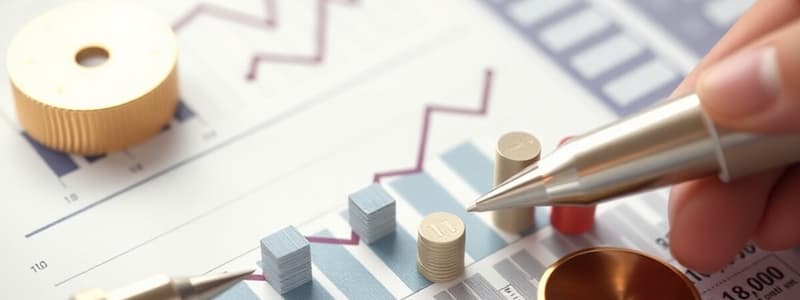Podcast
Questions and Answers
What equation is used to compute the standard deviation of returns?
What equation is used to compute the standard deviation of returns?
- Standard deviation = variance^2
- Standard deviation = 2 * variance
- Standard deviation = variance * expected return
- Standard deviation = square root of variance (correct)
Which investment has a higher level of risk as measured by standard deviation?
Which investment has a higher level of risk as measured by standard deviation?
- Investment Y
- Neither has risk
- Both have equal risk
- Investment X (correct)
If an investor desires a higher expected return, what is implied about the risk they must take?
If an investor desires a higher expected return, what is implied about the risk they must take?
- Risk must be minimized.
- They must take on less risk.
- There is no impact on risk.
- They must take on more risk. (correct)
How is the expected rate of return calculated?
How is the expected rate of return calculated?
Which of the following represents the proper sequence of steps for calculating returns and risk?
Which of the following represents the proper sequence of steps for calculating returns and risk?
What is the variance of the returns calculated for the publishing company’s common stock?
What is the variance of the returns calculated for the publishing company’s common stock?
In the context of investment, how should risk be viewed if the distribution of returns is symmetrical?
In the context of investment, how should risk be viewed if the distribution of returns is symmetrical?
What formula is used to calculate expected cash flow?
What formula is used to calculate expected cash flow?
Given a cash flow of $1,000 with a probability of 0.2, what is the contribution to expected cash flow?
Given a cash flow of $1,000 with a probability of 0.2, what is the contribution to expected cash flow?
What expected rate of return is associated with a cash inflow of $1,400 from a $10,000 investment?
What expected rate of return is associated with a cash inflow of $1,400 from a $10,000 investment?
If an investment shows an expected return of 12% based on a cash flow of $1,200, what is the cash flow value?
If an investment shows an expected return of 12% based on a cash flow of $1,200, what is the cash flow value?
In the expected rate of return calculation, if the probability of state 1 is 0.3 and the return is 10%, what is the expected return contribution?
In the expected rate of return calculation, if the probability of state 1 is 0.3 and the return is 10%, what is the expected return contribution?
What is the correct summation approach for multiple cash flow states?
What is the correct summation approach for multiple cash flow states?
If an investment involves a cash flow sequence with probabilities 0.3, 0.5, and 0.2, what must the total of probabilities equal?
If an investment involves a cash flow sequence with probabilities 0.3, 0.5, and 0.2, what must the total of probabilities equal?
How is the expected rate of return expressed in a scenario with multiple cash flow states?
How is the expected rate of return expressed in a scenario with multiple cash flow states?
What is the expected cash flow if the probabilities are 0.3, 0.4, and 0.3 with corresponding cash flows of $200, $300, and $500?
What is the expected cash flow if the probabilities are 0.3, 0.4, and 0.3 with corresponding cash flows of $200, $300, and $500?
Flashcards are hidden until you start studying
Study Notes
Expected Return
- To calculate the expected return for an investment, use the formula:
- (rate of return for state 1 * probability of state 1) + (rate of return for state 2 * probability of state 2) + ... (rate of return for state n * probability of state n)
Standard Deviation of Returns
- To calculate the riskiness of an investment, as measured by the standard deviation of returns, use the formula:
- (rate of return for state 1 - expected return)^2 * probability of state 1) + (rate of return for state 2 - expected return)^2 * probability of state 2) + ... (rate of return for state n - expected return)^2 * probability of state n)
Variance
- The variance is the square of the standard deviation.
Expected Cash Flow
- The expected cash flow is an average of all the possible cash flows, weighted by the probability that each cash flow will occur.
- The expected cash flow formula:
- (cash flow in state 1 * probability of state 1) + (cash flow in state 2 * probability of state 2) + ... (cash flow in state n * probability of state n)
Expected Rate of Return
- The expected rate of return is an average of all possible returns, weighted by the probability that each return will occur.
- The expected rate of return formula:
- (rate of return for state 1 * probability of state 1) + (rate of return for state 2 * probability of state 2) + ... (rate of return for state n * probability of state n)
Studying That Suits You
Use AI to generate personalized quizzes and flashcards to suit your learning preferences.




